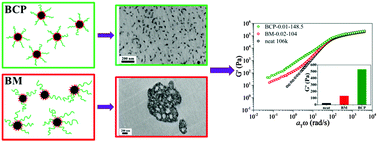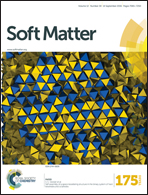Role of block copolymer adsorption versus bimodal grafting on nanoparticle self-assembly in polymer nanocomposites†
Abstract
We compare the self-assembly of silica nanoparticles (NPs) with physically adsorbed polystyrene-block-poly(2-vinylpyridine) (PS-b-P2VP) copolymers (BCP) against NPs with grafted bimodal (BM) brushes comprised of long, sparsely grafted PS chains and a short dense carpet of P2VP chains. As with grafted NPs, the dispersion state of the BCP NPs can be facilely tuned in PS matrices by varying the PS coverage on the NP surface or by changes in the ratio of the PS graft to matrix chain lengths. Surprisingly, the BCP NPs are remarkably better dispersed than the NPs tethered with bimodal brushes at comparable PS grafting densities. We postulate that this difference arises because of two factors inherent in the synthesis of the NPs: In the case of the BCP NPs the adsorption process is analogous to the chains being “grafted to” the NP surface, while the BM case corresponds to “grafting from” the surface. We have shown that the “grafted from” protocol yields patchy NPs even if the graft points are uniformly placed on each particle. This phenomenon, which is caused by chain conformation fluctuations, is exacerbated by the distribution function associated with the (small) number of grafts per particle. In contrast, in the case of BCP adsorption, each NP is more uniformly coated by a P2VP monolayer driven by the strongly favorable P2VP–silica interactions. Since each P2VP block is connected to a PS chain we conjecture that these adsorbed systems are closer to the limit of spatially uniform sparse brush coverage than the chemically grafted case. We finally show that the better NP dispersion resulting from BCP adsorption leads to larger mechanical reinforcement than those achieved with BM particles. These results emphasize that physical adsorption of BCPs is a simple, effective and practically promising strategy to direct NP dispersion in a chemically unfavorable polymer matrix.


 Please wait while we load your content...
Please wait while we load your content...